Originally published by AmmoLand.com.
USA – While many debate what the Best Home Defense Shotgun is, it’s hard to argue that the shotgun doesn’t make an ideal home defense weapon.
While capacity in terms of shell count will almost always be less than that of a semi-automatic pistol or modern sporting rifle, each one of those shells delivers a whole lot more impact that most any other choice.
Kinetic energy measurements don’t directly translate to fighting effectiveness; they do provide an illustration of the difference in destructive power between various firearms.
Consider a few examples:
- A 9mm pistol cartridge with a 124-grain projectile traveling at 1,250 feet per second delivers 430 foot-pounds of energy.
- A 5.56mm 55-grain rifle round moving at 3,240 feet per second delivers 1,282 foot-pounds.
- A 12-gauge, 9-pellet buckshot load with rated velocity of 1,450 feet per second delivers a whopping 2,240 foot-pounds of energy.
 Aimpoint 200018 Micro,...
Check Amazon for Pricing.
Aimpoint 200018 Micro,...
Check Amazon for Pricing.
That’s getting close to double the energy of a standard AR round over which the media incessantly frets.
Like most things, the decision as to whether to choose a shotgun for home defense depends on an evaluation of the tradeoffs that are important to you. The big factors boil down to better stopping effectiveness, higher recoil, and lower capacity. Which factors are most important to you?
If you decide to vote in favor of the shotgun, here are some things to consider when choosing the specific configuration for a home defense shotgun.
Home Defense Shotgun Ammo
Until you have to use it as a club, it’s the ammo and not the shotgun, that does the work. The shotgun is just the delivery mechanism.
The blessing and curse of the home defense shotguns or any shot gun, are the wide variety of ammunition types from which you can choose. At one end of the spectrum is tiny pellet and light recoiling birdshot. On the other end of the scale are giant hunks of lead called slugs. Just choosing a “home defense shotgun” is not enough. You have to make a careful and informed choice about the ammo that feeds it ( http://goo.gl/eP1NhG ) .
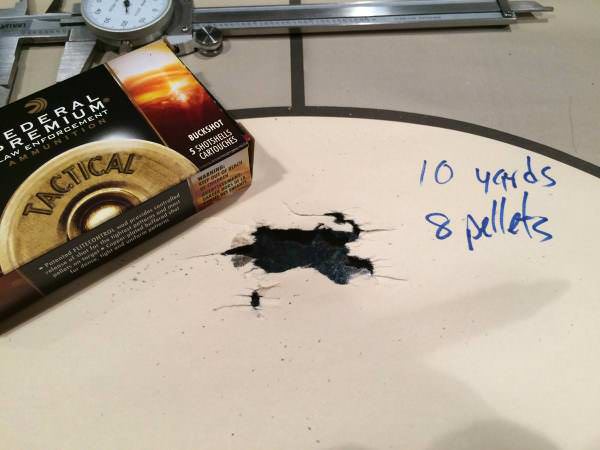
Here’s where things get interesting. Depending on the nature of your home, you might make very different ammo choices.
If you live in an apartment, you might need to be concerned with over-penetration through neighboring walls. Regardless of your personal danger, you’re still responsible if you launch buckshot or slugs into the next dwelling. Some folks prefer to use birdshot for this reason. Just be very careful that you understand what you’re sacrificing if you sway in that direction. At distances measured in feet, smaller birdshot will penetrate. However, when you start to get past 15 feet or so, the penetration capability begins to fail dramatically.
Yes, it’ll make a mess of an attacker, but may or may not stop them immediately.
Check Amazon for Pricing.
If you live in an isolated location, you might choose slugs. They’re amazingly effective at indoor distances, but you can also shoot them accurately out past 100-yards should the need arise.
Personally, I prefer the old standby ammo for shotgun-based home defense – Buckshot ( http://goo.gl/eP1NhG ).
Make no mistake, it will penetrate walls like a hot knife through butter, so you need to know what type of pattern your choice of gun and buckshot produce. I keep my Beretta 1301 Tactical shotgun loaded with Federal Premium 8-pellet 00 buckshot with FliteControl wads. These loads deliver amazingly small, and more importantly, predictable patterns. It will keep all pellets on a torso target from a range of 50-yards from this cylinder bore shotgun. At indoor distances, the pattern will stay smaller than a closed fist. In other words, I know where those pellets are going to go when I pull the trigger.
Whatever ammo you choose for your situation, it’s imperative that you test it at the range, a lot, so you know exactly how it’s going to behave. Every time you load a new brand or style of ammo you’ve got to test again.
Home Defense Shotgun Action?
Like most topics over which we incessantly argue, the choice of action type isn’t nearly as important as we would like to believe. A semi-automatic won’t necessarily fail when we need it most. A pump-action won’t necessarily work every single time. A break-action may just have enough ammo capacity to get the job done. Again, like most things, the user familiarity and skill are far more important than equipment choice.
If you like semi-automatics, then great, use that. They’re easy to operate and direct less recoil back in your direction. Modern semis are plenty reliable for home defense. Be sure to test your choice of home defense ammo a lot before sticking that gun by your nightstand. A quality semi-automatic home defense shotgun will reliably cycle most any type of standard shells from birdshot to slugs. Be sure to keep it clean and properly lubricated so it will continue to work when you need it to.
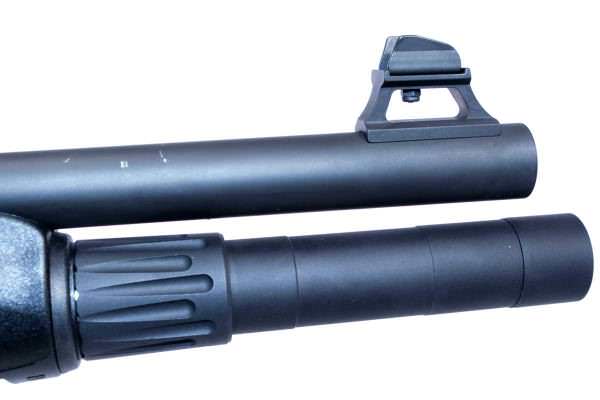
If you prefer the design of a pump gun for its simplicity and manual operation, that’s fine too.
While the mechanism of a pump isn’t likely to fail, user error can be a problem. To prevent short stroking the action during the heat of the moment, be sure to practice regularly.
The only downside to a break-action side by side or over and under is the limited capacity. I rule those designs out for that reason alone, but if it’s what you’ve got, then run with it! Just be sure to think through, and practice, a strategy for quick reloads should the need arise.
A Pistol Grip Only – Doesn’t Cut It
Just to be clear, we’re going to talk about two types of pistol grips here. Here, I’m referencing a pistol only grip. These are the shorty models you see with no buttstock whatsoever. The only part of your body supporting and aiming these beasts are your hands.

They look awesome, scary and tactical, and do have practical applications.
Door kickers use them for blowing locks apart just before their buddies storm into a room. For general home defense, these designs rank pretty far down my list.
Why?
Try shooting one with any degree of speed and accuracy. Contrary to popular assumption, you do have to aim a home defense shotgun, and it’s easy to miss with one, especially at indoor distances.
Depending on your specific choice of shot shell ammunition, the size of your shot pattern 15 feet from the muzzle might be just a couple of inches.
The most controllable way to control one of these is to shoot it from a low position. And guess what? When shooting from the hip, you’re not aiming. In a home-defense scenario, the very last thing you want to be doing is launching buckshot in random directions, possibly putting family members at risk too. If you try to shoot these holding it up to eye level, they’re difficult to control as there is no structured support to handle the recoil. Getting off an accurate and fast second shot is not easy.
Would I choose this over a 9-iron or an un-ripened plantain? Certainly.
However, considering that the big energy delivered by a shotgun also translates to big recoil, it’s not as good of a home defense choice as it might appear. Handy and maneuverable? Yes. Controllable? No.
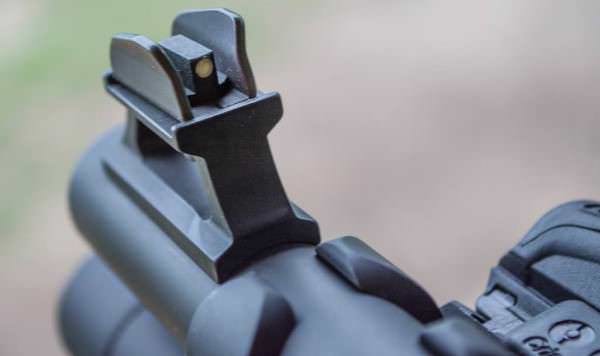
Pistol Grip vs. Traditional Grip
Speaking of pistol grips, one thing you may want to consider is a stocked pistol grip. Still a personal preference decision, a pistol grip (with stock!) can give you a little more control over the shotgun with your strong hand. While you don’t want to fire a home defense shotgun one-handed, even with a pistol grip, it may make it easier to do things like open doors or hold a flashlight in your support hand.
Many turkey hunting shotguns have pistol grips for a reason. The natural angle of your wrist lines up well with a more vertical grip, thereby eliminating strain. While the traditional shotgun grip is great for swinging through moving targets, you might find the pistol grip more natural for home defense scenarios where you’re carrying the gun and deliberately aiming.
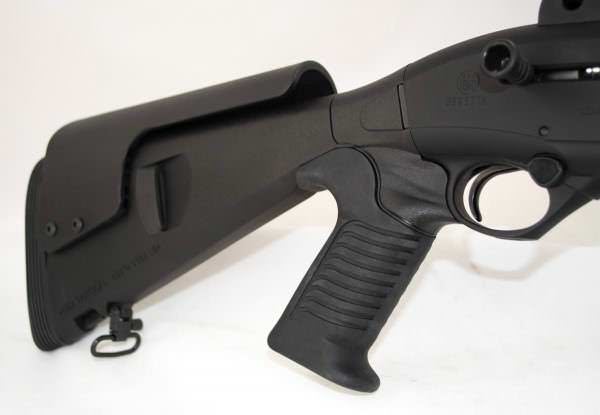
One other related advantage to a stocked pistol grip configuration is that you might be able to make the whole shotgun shorter and more compact, and, therefore, easier to maneuver indoors. In the example Beretta 1301 Tactical shown above, I replaced the factory stock with a Mesa Tactical Urbino Pistol Grip Stock ( http://goo.gl/p4KQ3G ) . The original length of pull was 13.75 inches, but with the Mesa Tactical Urbino stock, the length of pull is now just 12.5 inches.
It’s about as compact as you can get with a legal length barrel.
A stocked-pistol grip allows you to maintain a more compact shooting stance. A traditional shotgun grip encourages your elbow to “chicken wing” to the side. Tucking your firing arm in close your body requires an unnatural bend of your wrist. You’ll find that the natural position of your shooting side elbow with a pistol grip configuration is much closer to your body. Significant? Maybe or maybe not, but it’s something to consider.
With all that said, the addition of a pistol grip stock isn’t a requirement for a home defense shotgun. I prefer it, but that’s just a personal preference. It’s something to try if you’re piecing together your ultimate home defense smoothbore.
Home Defense Shotgun Lights & Lasers
Light and lasers on a home defense shotgun? For personal defense applications, absolutely yes if you can.
Before you pull the trigger on a shotgun in the dark, you want to be absolutely sure of your target, right? Fortunately, there are nearly infinite options on the market for shotgun lights. You can get fancy and install an integrated light and forend. Or, you can duct tape a Mag-Lite ( tiny.cc/88nc3x ) to the magazine tube. A low cost and less kludgy option is to use a barrel and magazine tube clamp like those offered by Mesa Tactical. These allow you to add a dedicated light mount or a small rail section to which you can attach whatever you want. The Beretta 1301 shown in the photos here has a Crimson Trace Rail Master Pro ( http://goo.gl/9cPGnK ) integrated light and laser. I keep it mounted on the shooting side, so my support hand finger can easily reach the activation paddles.

Home Defense Shotgun Optical Sights
For wingshooting, optical sights aren’t so hot. For home defense, they bring a whole new dimension of effectiveness to low light shooting. You might consider an always-on red dot optic like the Aimpoint Micro ( http://goo.gl/ogPI7W ) . You literally can leave it turned on all the time, so it’s ready to go, day or night. Change the battery every New Years Day and you’ll never have to worry about the dot not being present. If you shoot a tight-patterning buckshot load like the Federal FliteControl ammo, you can be amazingly fast, yet precise.
Mounted correctly, you’ll be able to see your iron sights through the glass in the event that your optic goes down.
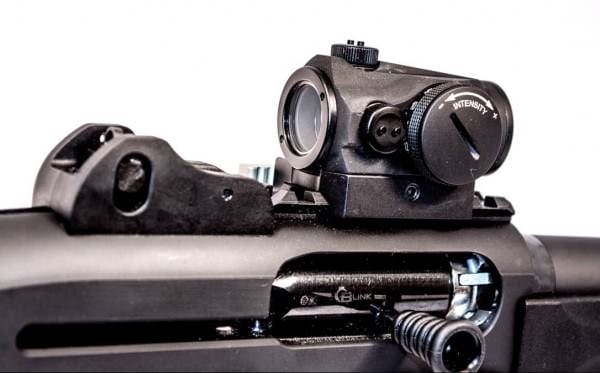
Home Defense Shotgun Ammo Holders
Like most of the other items on this list, Shotgun Shell Holders ( http://goo.gl/dRrT48 ) aren’t there to look cool. It’s on the list because home defense shotgun have low capacity to start with, and they’re insatiable ammo eaters once you start shooting them. Unlike a semi-auto pistol or rifle, sticking an extra magazine in your pocket (especially if you sleep naked) isn’t really an option with shotgun shells.
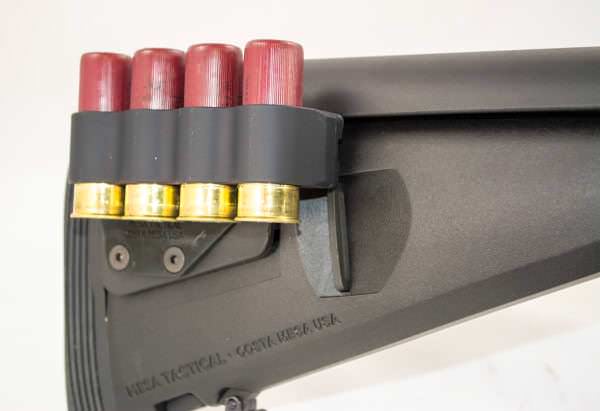
For illustrative purposes, I have the shotgun shown here equipped with Mesa Tactical receiver and the basic Mesa stock shell carrier ( http://goo.gl/HQiN3T ). Pick one style, the other, or both. If you’re on a budget, consider those Velcro shell carriers that stick to the receiver. While they may look low-budget, you’ll find that many serious shotgun fighters use these. You can carry some loaded strips in a pocket or magazine pouch.
When the one on the receiver runs dry, just rip on the empty strip and slap a new one on. It’s almost like changing magazines.
A Home Defense Shotgun Needs a Good Sling
Last but certainly not least is the lowly and often disrespected sling. Just like with your AR Rifle Sling, the purpose isn’t to be high speed and low drag. On the contrary, the real purpose is far more mundane. A sling is a holster for your shotgun. If you need to use your hands for other things, a proper sling allows you to simply let go of your home defense shotgun, and it will be secured, but still immediately accessible. I really like the Viking Tactics Original Sling ( http://goo.gl/9cM0sl ) for my rifles and shotguns. It’s got a brilliant quick adjustment mechanism which allows you to open it large for ambidextrous shooting or cinch it up right using one hand.
There’s a lot here, and the idea is not to build a 42-pound, mall ninja special home defense shotgun. The idea is to provide some food for thought about what options might make the most sense for you given your specific home-defense situation.
Whatever gear you choose for your kick-ass home defense shotgun, be sure to practice with it not until you get the operation right, but until you can’t get it wrong.
Reprinted with permission from AmmoLand.com.





